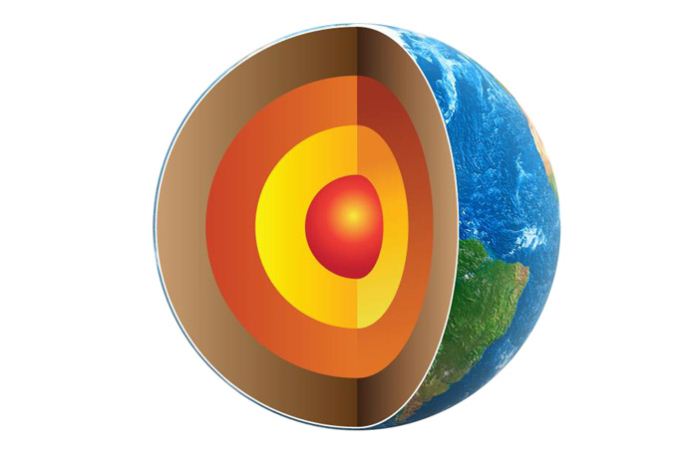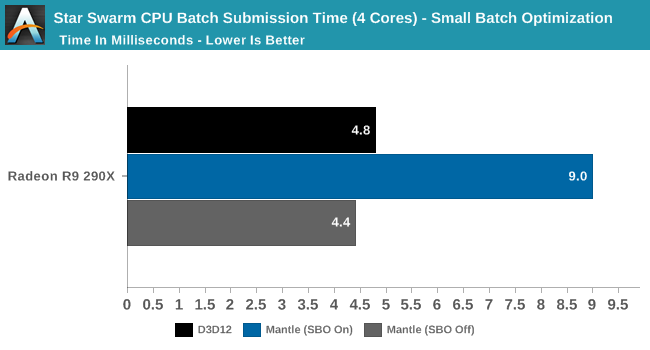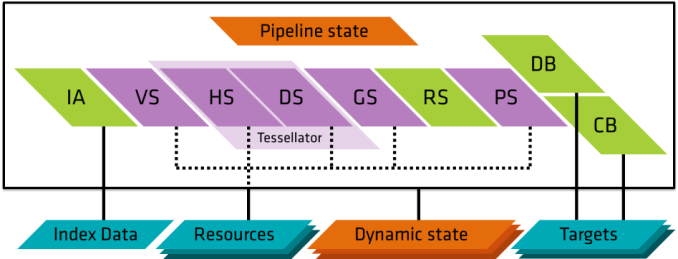AMD Lays Out Future of Mantle: Changing Direction In Face of DX12 and glNext
by Ryan Smith on March 2, 2015 10:45 PM EST
Much has been made over the advent of low-level graphics APIs over the last year, with APIs based on this concept having sprouted up on a number of platforms in a very short period of time. For game developers this has changed the API landscape dramatically in the last couple of years, and it’s no surprise that as a result API news has been centered on the annual Game Developers Conference. With the 2015 conference taking place this week, we’re going to hear a lot more about it in the run-up to the release of DirectX 12 and other APIs.
Kicking things off this week is AMD, who is going first with an update on Mantle, their in-house low-level API. The first announced of the low-level APIs and so far limited to AMD’s GCN’s architecture, there has been quite a bit of pondering over the future of the API in light of the more recent developments of DirectX 12 and glNext. AMD in turn is seeking to answer these questions first, before Microsoft and Khronos take the stage later this week for their own announcements.
In a news post on AMD’s gaming website, AMD has announced that due to the progress on DX12 and glNext, the company is changing direction on the API. The API will be sticking around, but AMD’s earlier plans have partially changed. As originally planned, AMD is transitioning Mantle application development from a closed beta to a (quasi) released product – via the release of a programming guide and API reference this month – however AMD’s broader plans to also release a Mantle SDK to allow full access, particularly allowing iit to be implemented on other hardware, has been shelved. In place of that AMD is refocusing Mantle on being a “graphics innovation platform” to develop new technologies.
As far as “Mantle 1.0” is concerned, AMD is acknowledging at this point that Mantle’s greatest benefits – reduced CPU usage due to low-level command buffer submission – is something that DX12 and glNext can do just as well, negating the need for Mantle in this context. For AMD this is still something of a win because it has led to Microsoft and Khronos implementing the core ideas of Mantle in the first place, but it also means that Mantle would be relegated to a third wheel. As a result AMD is shifting focus, and advising developers looking to tap Mantle for its draw call benefits (and other features also found in DX12/glNext) to just use those forthcoming APIs instead.

Mantle’s new focus in turn is going to be a testbed for future graphics API development. Along with releasing the specifications for “Mantle 1.0”, AMD will essentially keep the closed beta program open for the continued development of Mantle, building it in conjunction with a limited number of partners in a fashion similar to how Mantle has been developed so far.
Thie biggest change here is that any plans to make Mantle open have been put on hold for the moment with the cancelation of the Mantle SDK. With Mantle going back into development and made redundant by DX12/glNext, AMD has canned what was from the start the hardest to develop/least likely to occur API feature, keeping it proprietary (at least for now) for future development. Which is not to say that AMD has given up on their “open” ideals entirely though, as the company is promising to deliver more information on their long-term plans for the API on the 5th, including their future plans for openness.
As for what happens from here, we will have to see what AMD announces later this week. AMD’s announcement is essentially in two parts: today’s disclosure on the status of Mantle, and a further announcement on the 5th. It’s quite likely that AMD already has their future Mantle features in mind, and will want to discuss those after the DX12 and glNext disclosures.
Finally, from a consumer perspective Mantle won’t be going anywhere. Mantle remains in AMD’s drivers and Mantle applications continue to work, and for that matter there are still more Mantle enabled games to come (pretty much anything Frostbite, for a start). How many more games beyond 2015 though – basically anything post-DX12 – remains to be seen, as developers capable of targeting Mantle will almost certainly want to target DX12 as well as soon as it’s ready.
Update 03/03: To add some further context to AMD's announcement, we have the announcement of Vulkan (aka glNext). In short Mantle is being used as a building block for Vulkan, making Vulkan a derivative of Mantle. So although Mantle proper goes back under wraps at AMD, "Mantle 1.0" continues on in an evolved form as Vulkan.
Source: AMD











94 Comments
View All Comments
Wreckage - Tuesday, March 3, 2015 - link
OpenGL was also ahead of Mantle. Mantle is just like 3DFX GLIDE and we all know what happened to 3DFX. Looks like AMD did not learn from history and soon shall repeat it.Samus - Tuesday, March 3, 2015 - link
The only similarity is has to GLide is it's proprietary.Similarities end there. GLide was just that, an IDE, not an API. It could be wrapped and emulated with little performance loss to OpenGL.
Mantel is one of those things that developers have been talking about for awhile and for some reason it took AMD to finally listen and put together an API. After the industry saw the working concept had tangible benefits, everyone is behind the idea now of moving closer to the hardware interface and eliminating as much software overhead as possible.
Could AMD have made Mantel universal...of course. And they probably should have. But they are a publicly traded company and are not in the business of giving away millions of dollars in research. AMD would have kept x86-64 (AMD64) to itself if it wasn't obligated to share it with Intel via their licensing agreement...and it's important to note Intel benefited from many AMD manufacturing innovations via this agreement, too. IMC (integrated memory controller) and various lithography/material patents AMD was forced to share with Intel via their contract, which is all BS because AMD doesn't get much back from Intel in this regard.
CPUGPUGURU - Tuesday, March 3, 2015 - link
STOP BSingAMD DID NOT share AMD64, Intel reversed engineered it. AMD was not FORCED to share anything it was IBM that forced Intel to share X86.
CPUGPUGURU - Tuesday, March 3, 2015 - link
Hey AMD pump boy,AMD was NEVER OBLIGATED to share AMD64, AMD was NEVER forced to share MANUFACTURING innovations, "IMC (integrated memory controller) and various lithography/material patents" NEVER.
Prove it or STFU!!! I hate LIARS.
Crunchy005 - Wednesday, March 4, 2015 - link
did some googleing."Intel is currently also a licensee of the AMD64 extensions, which Intel calls EM64T, AFAIK."
http://siliconmadness.blogspot.com/2009/03/amd-bre...
"AMD noted to Ars that it has a number of patents of its own, including some related to the functionality of integrated memory controllers, the x86-64 instruction set, and x86 multicore configurations. The company also hinted that it may hold patents regarding the creation of an integrated CPU+GPU product on a single die—the so-called "Fusion" parts that now appear on the roadmaps of both companies."
http://arstechnica.com/gadgets/2009/03/amd-intel-e...
On top of this the intel 64 bit version failed miserably, stop thinking intel is some brilliant company they have pushed technologies because of AMD. Integrated GPUs anyone? That was AMDs patent first. After AMD APUs came out intel HD graphics popped up. Competition it's a thing and it is needed. Also CPUGPUGURU you need to calm down and stop with the rosey intel glasses. Intel is a boring company that has just worked on improving it's own core architecture with no thought or creativity behind it, if anything AMD should at least be praised for the risks it has taken and how it thinking outside of the box(Intel thinks inside of a very small box) have pushed the industry as a whole.
CPUGPUGURU - Wednesday, March 4, 2015 - link
BSing AMD pump boy Intel had integrated graphics first and that was before Sandy Bridge and its ring bus that is a lot faster than AMD's on-die northbridge—the ring bus design connects the CPU and GPU at 384GB/s, while the link between AMD's northbridge and the GPU is 27GB/ which came out before AMD's Watt Sucking IPC cripple APUs.Intel x86 64 Bit DID NOT Fail and was reverse engineered and Again AMD was NEVER OBLIGATED to share AMD64, AMD was NEVER forced to share MANUFACTURING innovations, "IMC (integrated memory controller) and various lithography/material patents" NEVER.
Crunchy005 - Wednesday, March 4, 2015 - link
Ya they weren't forced they did it because didn't we all feel sorry for Intel when titanium fell through? Intel x86-64 is licensed from AMD, find me proof that it was reverse engineered or STFU. And Itanium was not x86-64 it was a 64bit only architecture it couldn't run anything 32bit which is why AMDs x86-64 option was better at the time since 64bit software wasn't huge yet. I mena really I gave you articles and googled some before I posted can you please not yell at me like that it makes you look like an idiot and you provide no proof to your side of the argument.ppi - Wednesday, March 4, 2015 - link
It was reverse-engineered. Which is allowed for some reason. Now ... if you want to get control AMD, with their x86-64, you might succeed in "clean room reverse engineering" of 16- and 32-bit x86 and get free of Intel's patent grasp.I do not understand patenting specification concept anyway.
0VERL0RD - Wednesday, March 4, 2015 - link
Don't think Glide can be blamed solely for 3DFX's demise. That lies with poor management decisions like buying STB which annoyed OEMS & introducing late products!gruffi - Wednesday, March 4, 2015 - link
Yeah, DX12 development is ahead of Mantle. That's why there are so many DX12 games out there. Oh wait, we don't even have o proper DX12 OS.Sometimes I wonder if people really believe the nonsense they write. You just sound like the typical deluded Nvidia fangirl.
The truth is, Vulkan and DX12 were inspired by Mantle. No Mantle, no Vulkan and no DX12. Vulkan is actually a Mantle fork. And it seems that Mantle and Vulkan are ahead of DX12 in terms of functionality. You should be thankful to AMD for improving the whole industry with open initiatives. Something Nvidia has never done before. You remember their PhysX disaster? And CUDA fades away too. Finally more and more developers use OpenCL and other open standards.